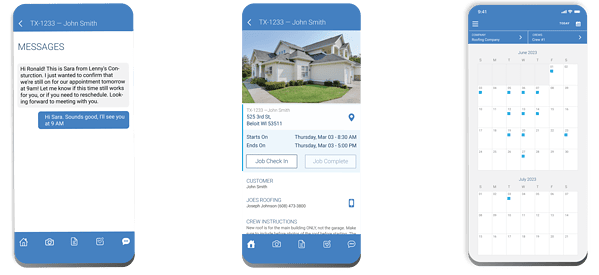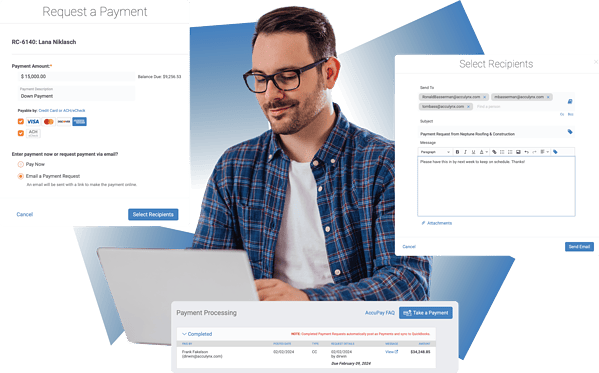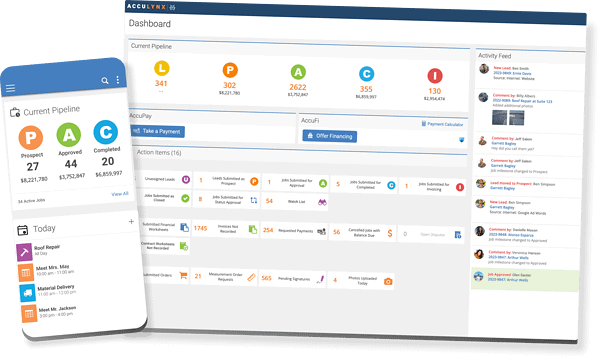The roofing industry has seen an explosion of new technology in the past few years. While these tools are transforming the way contractors do business, they may be overwhelming if you’re just now starting to implement them. If that’s the case, targeting specific parts of your operation that you want to improve with roofing technology will allow you to make impactful changes in the short term and increase your profitability in the long term.
Here are 4 areas where roofers are seeing the greatest ROI from their technology usage—and the specific tools that are helping them work smarter.
- Increasing productivity
- Taking customer service to the next level
- Improving efficiency
- Managing your business more effectively
#1: Increasing productivity
Do you and your team members use your smartphones or tablets as part of your roofing work?
Studies have shown that, “managers and executives observe a 34% productivity surge when employees use cell phones for work tasks.” The right roofing technology can help you use your smartphone to stay productive from anywhere and access important details on the go.
From photographing job sites to getting contracts signed, there are more ways than ever to use your mobile device. Here are a few apps to consider incorporating into your roofing workflow:
- Canvassing and sales apps
- Lead generation apps
- Photo management apps
- Roofing design apps
- Subcontractor and crew management apps
- Business management apps
AccuLynx’s mobile Field App is a business management app that enables roofers to take the power of AccuLynx into the field. Contractors can use the AccuLynx Field App to:
- Review activity, tasks, and schedules
- Access job details
- Log calls
- Order aerial roofing measurements
- And more!
AccuLynx also offers a mobile Crew App for easy crew management, communication, and visibility. With the mobile Crew App, sub-contractors and crews can:
- View job assignments
- Access work orders
- Send messages
- Update checklists
- Capture & share photos
Increasing productivity is never a simple goal, but utilizing roofing technology apps on your team’s mobile devices can help you accomplish it while streamlining processes.

#2: Taking customer service to the next level
3 out of 4 consumers will spend more with a business that provides a strong customer experience. Investing in roofing technology tools that will improve customer satisfaction and allow you to offer a wider range of services can lead to greater profits
Using a business texting service
Many customers’ preferred method of communication is text messaging. 83% of customers would like to receive appointment reminders via text, and 69% of customers want to contact businesses by texting. Providing a way for homeowners to send and receive text messages with your business is a great way to take your customer service to the next level.
However, messaging with homeowners on a personal or company phone can lead to complications, as these devices may not be secure, it can be difficult to look back at past messages, and only one user has access to the device at a time. Using a business texting platform, such as the texting add-on in AccuLynx, will let you take advantage of the benefits of texting while avoiding the pitfalls of using a personal or company device.
Offering electronic signatures and digital documents
Over the past few years, many customers have gotten used to the convenience of completing most tasks online, and have come to expect it from the businesses they interact with. One way you can cater to this customer preference—and speed up the document approval process—is by adopting roofing technology tools that allow you to capture electronic signatures.
These tools, such as the Smart(er) Docs feature in AccuLynx, make it easy to email documents to customers and receive a legally binding electronic signature. You’ll get notified as soon as a document is signed, and the customer will receive a copy of the signed document. Both you and your customers will be happy with the ease and speed of e-signing.
Accepting digital payments
Another area where customers have come to expect maximum flexibility and convenience is payment for services. Using an electronic payment processing service will help you provide homeowners with more payment options and get paid faster.
AccuLynx’s simple payment processing system allows you to accept credit, debit, and ACH payments directly from the software, with no need for an external card reader. You can even send a payment request by email, saving you a visit to the job site and allowing homeowners to pay on their own time.

#3: Improving efficiency
51% of workers spend at least 2 hours per day on repetitive tasks, which adds up fast—40 hours of time per month, or almost a full work week! Roofing technology can add this time back to your schedule by eliminating many of the repetition of these tasks.
Using aerial measurement services
Climbing up on a roof to measure it is time-consuming, risky, and difficult to do accurately. Aerial measurement companies, such as EagleView and GAF QuickMeasure, simplify the measuring of roofs.
Instead of manually measuring a roof, you can order an aerial measurement report, which uses drone-captured images to accurately calculate the slopes, areas, and other essential components of a roof. These reports can be ordered online with the click of a button and delivered to your roofing company in hours, helping you speed up the estimation process. AccuLynx integrates with leading aerial measurement providers so you can get reports delivered directly to your digital job files, saving you even more time.
Ordering materials online
Material ordering is another aspect of your roofing jobs that can take hours the old-fashioned way—or just a few minutes using roofing technology. Ordering materials online from your supplier rather than calling on the phone is the first step in speeding up the ordering process.
However, to make your orders truly efficient, they also need to reflect accurate pricing and availability. The material supplier integrations in AccuLynx allow you to access your unique pricing, see what materials are available, and order directly from ABC, QXO, or SRS in the software.
Automating communications
Communicating with leads, customers, and team members can take up significant time in your day. Using automations to send routine communications is one way to save time on this process. Automations allow you to send a pre-set message every time a certain condition is met, rather than having to create a new message every time.
For instance, in AccuLynx, you can use the Automation Manager to:
- Set up a text message reminder that is automatically sent whenever a new appointment is scheduled.
- Create a customer follow-up email that triggers when a job is marked as completed.
- Automatically assign a team member the task of building an order as soon as a job has been approved.
Not only does this reduce the time spent on routine tasks, this also makes it easier for your roofing business to stay on top of communications.
#4: Managing your business more effectively
97% of businesses that use a CRM or other business management software met or exceeded their sales goals last year. Finding a software system that can help you manage every aspect of your roofing business will enable you to stay organized, on task, and handle a larger volume of work.
Utilizing a roofing CRM software
It’s important to find the best tools to help you grow your roofing business. But using multiple roofing technology solutions can create new complications, as you manage the way they interact with each other and search for information in multiple places. Investing in business management software specifically built for contractors like a roofing CRM will bring your tools together in a single system.
AccuLynx is an all-in-one CRM system that is designed specifically for the way roofing contractors work. There’s no adjustment needed—everything from the dashboard to the production calendar to the estimating tools was intended for your residential roofing business to easily use.

See greater ROI with AccuLynx
AccuLynx has all the tools you need to increase your productivity, improve your customer service, reduce repetitive tasks, and manage every aspect of your business. When you invest in our roofing software, you’ll see incredible ROI and be better equipped to grow your business.
See a custom demo today to learn more.
